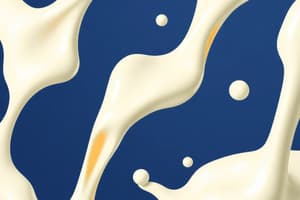Podcast
Questions and Answers
What is the primary goal of milk pasteurization?
What is the primary goal of milk pasteurization?
- To improve the nutritional content of milk
- To increase the production of dairy products
- To enhance the flavor and texture of milk
- To eliminate pathogenic bacteria and extend shelf life (correct)
Which type of pasteurization involves heating milk to 72°C (161°F) for 15 seconds?
Which type of pasteurization involves heating milk to 72°C (161°F) for 15 seconds?
- Ultra-Pasteurization (UHT)
- Aseptic Packaging
- High-Temperature Short-Time (HTST) (correct)
- Low-Temperature Long-Time (LTLT)
What is a common effect of pasteurization on milk proteins?
What is a common effect of pasteurization on milk proteins?
- It denatures proteins, affecting milk's nutritional properties (correct)
- It enhances the nutritional content of milk
- It has no effect on milk proteins
- It activates enzymes that affect milk quality
What regulates the minimum pasteurization temperatures and holding times for milk and dairy products?
What regulates the minimum pasteurization temperatures and holding times for milk and dairy products?
What is the primary benefit of Ultra-Pasteurization (UHT)?
What is the primary benefit of Ultra-Pasteurization (UHT)?
Why is pasteurization necessary for milk and dairy products?
Why is pasteurization necessary for milk and dairy products?
Flashcards are hidden until you start studying
Study Notes
What is Milk Pasteurization?
Milk pasteurization is a heat treatment process aimed at killing bacteria and extending the shelf life of milk and dairy products.
Why is Pasteurization Necessary?
- To eliminate pathogenic bacteria (e.g., Salmonella, Listeria, E. coli) that can cause illness
- To reduce the risk of milk-borne diseases
- To increase the shelf life of milk and dairy products
Types of Pasteurization:
- Low-Temperature Long-Time (LTLT): Heat milk to 63°C (145°F) for 30 minutes
- High-Temperature Short-Time (HTST): Heat milk to 72°C (161°F) for 15 seconds
- Ultra-Pasteurization (UHT): Heat milk to 135°C (275°F) for 2 seconds
- Aseptic Packaging: Combine HTST with aseptic packaging to create a sterile environment
Effects of Pasteurization:
- Kills most bacteria, including pathogens and spoilage microorganisms
- Inactivates enzymes that affect milk quality
- Denatures proteins, affecting milk's nutritional properties
- Can affect the flavor, texture, and nutritional content of milk
Regulations and Standards:
- Varying regulations and standards exist worldwide, such as those set by the US FDA and the EU's Dairy Hygiene Directive
- Regulations dictate the minimum pasteurization temperatures and holding times required for milk and dairy products
Conclusion:
Milk pasteurization is a crucial step in ensuring the safety and quality of milk and dairy products. The type and duration of pasteurization depend on the desired outcome and local regulations.
What is Milk Pasteurization?
- Milk pasteurization is a heat treatment process that kills bacteria and extends the shelf life of milk and dairy products.
Why is Pasteurization Necessary?
- Eliminates pathogenic bacteria such as Salmonella, Listeria, and E.coli that can cause illness.
- Reduces the risk of milk-borne diseases.
- Increases the shelf life of milk and dairy products.
Types of Pasteurization:
- Low-Temperature Long-Time (LTLT): heats milk to 63°C (145°F) for 30 minutes.
- High-Temperature Short-Time (HTST): heats milk to 72°C (161°F) for 15 seconds.
- Ultra-Pasteurization (UHT): heats milk to 135°C (275°F) for 2 seconds.
- Aseptic Packaging: combines HTST with aseptic packaging to create a sterile environment.
Effects of Pasteurization:
- Kills most bacteria, including pathogens and spoilage microorganisms.
- Inactivates enzymes that affect milk quality.
- Denatures proteins, affecting milk's nutritional properties.
- Affects the flavor, texture, and nutritional content of milk.
Regulations and Standards:
- Regulations and standards for milk pasteurization vary worldwide.
- Examples of regulations include those set by the US FDA and the EU's Dairy Hygiene Directive.
- Regulations dictate the minimum pasteurization temperatures and holding times required for milk and dairy products.
Studying That Suits You
Use AI to generate personalized quizzes and flashcards to suit your learning preferences.




